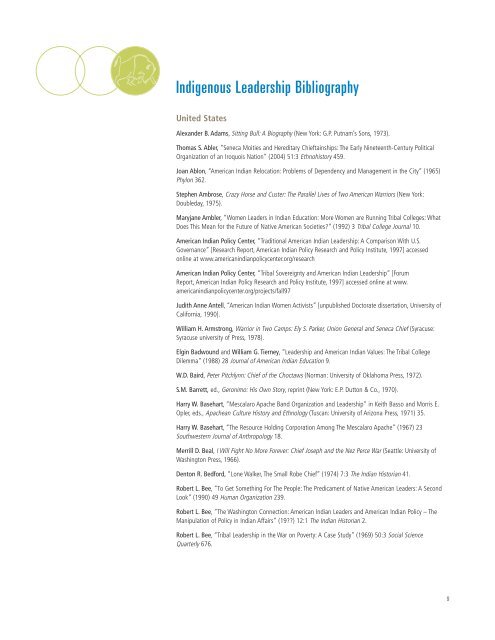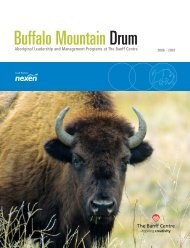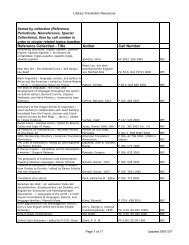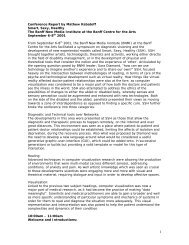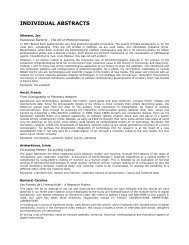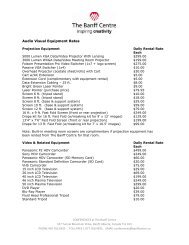Indigenous Leadership Bibliography - The Banff Centre
Indigenous Leadership Bibliography - The Banff Centre
Indigenous Leadership Bibliography - The Banff Centre
You also want an ePaper? Increase the reach of your titles
YUMPU automatically turns print PDFs into web optimized ePapers that Google loves.
<strong>Indigenous</strong> <strong>Leadership</strong> <strong>Bibliography</strong><br />
United States<br />
Alexander B. Adams, Sitting Bull: A Biography (New York: G.P. Putnam’s Sons, 1973).<br />
Thomas S. Abler, “Seneca Moities and Hereditary Chieftainships: <strong>The</strong> Early Nineteenth-Century Political<br />
Organization of an Iroquois Nation” (2004) 51:3 Ethnohistory 459.<br />
Joan Ablon, “American Indian Relocation: Problems of Dependency and Management in the City” (1965)<br />
Phylon 362.<br />
Stephen Ambrose, Crazy Horse and Custer: <strong>The</strong> Parallel Lives of Two American Warriors (New York:<br />
Doubleday, 1975).<br />
Maryjane Ambler, “Women Leaders in Indian Education: More Women are Running Tribal Colleges: What<br />
Does This Mean for the Future of Native American Societies?” (1992) 3 Tribal College Journal 10.<br />
American Indian Policy Center, “Traditional American Indian <strong>Leadership</strong>: A Comparison With U.S.<br />
Governance” [Research Report, American Indian Policy Research and Policy Institute, 1997] accessed<br />
online at www.americanindianpolicycenter.org/research<br />
American Indian Policy Center, “Tribal Sovereignty and American Indian <strong>Leadership</strong>” [Forum<br />
Report, American Indian Policy Research and Policy Institute, 1997] accessed online at www.<br />
americanindianpolicycenter.org/projects/fall97<br />
Judith Anne Antell, “American Indian Women Activists” [unpublished Doctorate dissertation, University of<br />
California, 1990].<br />
William H. Armstrong, Warrior in Two Camps: Ely S. Parker, Union General and Seneca Chief (Syracuse:<br />
Syracuse university of Press, 1978).<br />
Elgin Badwound and William G. Tierney, “<strong>Leadership</strong> and American Indian Values: <strong>The</strong> Tribal College<br />
Dilemma” (1988) 28 Journal of American Indian Education 9.<br />
W.D. Baird, Peter Pitchlynn: Chief of the Choctaws (Norman: University of Oklahoma Press, 1972).<br />
S.M. Barrett, ed., Geronimo: His Own Story, reprint (New York: E.P. Dutton & Co., 1970).<br />
Harry W. Basehart, “Mescalaro Apache Band Organization and <strong>Leadership</strong>” in Keith Basso and Morris E.<br />
Opler, eds., Apachean Culture History and Ethnology (Tuscan: University of Arizona Press, 1971) 35.<br />
Harry W. Basehart, “<strong>The</strong> Resource Holding Corporation Among <strong>The</strong> Mescalaro Apache” (1967) 23<br />
Southwestern Journal of Anthropology 18.<br />
Merrill D. Beal, I Will Fight No More Forever: Chief Joseph and the Nez Perce War (Seattle: University of<br />
Washington Press, 1966).<br />
Denton R. Bedford, “Lone Walker, <strong>The</strong> Small Robe Chief” (1974) 7:3 <strong>The</strong> Indian Historian 41.<br />
Robert L. Bee, “To Get Something For <strong>The</strong> People: <strong>The</strong> Predicament of Native American Leaders: A Second<br />
Look” (1990) 49 Human Organization 239.<br />
Robert L. Bee, “<strong>The</strong> Washington Connection: American Indian Leaders and American Indian Policy – <strong>The</strong><br />
Manipulation of Policy in Indian Affairs” (19??) 12:1 <strong>The</strong> Indian Historian 2.<br />
Robert L. Bee, “Tribal <strong>Leadership</strong> in the War on Poverty: A Case Study” (1969) 50:3 Social Science<br />
Quarterly 676.<br />
9


